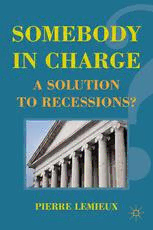
Somebody in Charge: A Solution to Recessions? PDF
Preview Somebody in Charge: A Solution to Recessions?
Somebody in Charge Somebody in Charge A Solution to Recessions? PierreLemieux somebodyincharge Copyright©PierreLemieux,2011. Softcoverreprintofthehardcover1stedition2011 978-0-230-11269-8 Allrightsreserved. Firstpublishedin2011by PALGRAVEMACMILLAN® intheUnitedStates—adivisionofSt.Martin’sPressLLC, 175FifthAvenue,NewYork,NY10010. WherethisbookisdistributedintheUK,EuropeandtherestoftheWorld, thisisbyPalgraveMacmillan,adivisionofMacmillanPublishersLimited, registeredinEngland,companynumber785998,ofHoundmills,Basingstoke, HampshireRG216XS. PalgraveMacmillanistheglobalacademicimprintoftheabovecompanies andhascompaniesandrepresentativesthroughouttheworld. Palgrave®andMacmillan®areregisteredtrademarksintheUnitedStates, theUnitedKingdom,Europeandothercountries. ISBN 978-1-349-29461-9 ISBN 978-0-230-11847-8 (eBook) DOI 10.1057/9780230118478 LibraryofCongressCataloging-in-PublicationData Lemieux,Pierre. Somebodyincharge:asolutiontorecessions?/byPierreLemieux. p. cm. Includesbibliographicalreferences. 1. Recessions. 2. Financialcrises—Prevention. 3. Economic policy. I. Title. HB3711.L572011 338.5(cid:2)43—dc22 2010037347 AcataloguerecordofthebookisavailablefromtheBritishLibrary DesignbyIntegraSoftwareServices Firstedition:March2011 10 9 8 7 6 5 4 3 2 1 TransferredtoDigitalPrintingin2012 Contents ListofCharts vii Acknowledgments ix AFewAcronyms xi Introduction:AdultSupervision 1 1 TheLimitsofAuthority 9 2 Keynes’sOldClothes 39 3 TheCarofCollectivism 63 4 TheLaissez-FaireScapegoat 83 5 TheCrimeScene 103 6 MonetaryMeddling 123 7 TheState’sAnimalSpirits 133 Conclusion:TheEmperor’sNewClothes 155 Notes 165 Bibliography 185 Index 201 List of Charts 1 TotalgovernmentexpenditurespercapitaintheUnitedStates 69 2 RegulatoryexpendituresbytheU.S.federalgovernment, 1960–2007 75 Acknowledgments Iwishtothankafewcolleagueswhohavereadpartsofthemanuscriptofthis book: Christian Calmès (Department of Management Sciences, University of Québec in Outaouais), Mark Brady and Jeff Hummel (Department of Economics, San Jose State University), and David Henderson (Naval Post- graduate School and Hoover Institution). I spent the winter of 2009–2010 as a visiting scholar at the Department of Economics at San Jose State University, where many colleagues suggested useful ideas during informal conversations. Alex Tabarrok of George Mason University’s Department of Economics as well as an anonymous referee provided useful criticism on a previousversionofthemanuscript.IalsowanttothanktheAureaFounda- tion (Toronto) and its advisor George Jonas for a grant that allowed me to spendtimeawayresearchingandwritingthisbook.Ofcourse,noneofthese colleagues,friends,orinstitutionsisresponsibleforanymistakeIhavemade, nordotheynecessarilysharetheopinionsIexpress. A Few Acronyms ABCP Asset-backedcommercialpaper ARM Adjustable-ratemortgage BEA BureauofEconomicAnalysis BLS BureauofLaborStatistics CBO CongressionalBudgetOffice CDO Collaterizeddebtobligation CDS Creditdefaultswap CPI Consumerpriceindex GDP Grossdomesticproduct GSE Government-sponsoredenterprise IMF InternationalMonetaryFund MBS Mortgage-backedsecurity NBER NationalBureauofEconomicResearch OTS OfficeofThriftSupervision OMB OfficeofManagementandBudget RBC Realbusinesscycles S&L SavingsandLoansAssociation SIV Specialinvestmentvehicle SPV Specialpurposevehicle TARP TroubledAssetsReliefProgram Introduction: Adult Supervision On August 9, 2007, at about 9:30 Eastern time, traders knew somethingverywrongwashappening. Traders buy and sell securities (stocks, bonds, etc.) for their own companiesorfortheircustomers.JPMorganChase,forexample,hasanum- beroftradingroomsinitsheadquarterstoweronParkAvenueinNewYork City.Itscredittradingroom,whichdealswithcreditinstruments(asopposed tostocks),hasseveralhundredtradingdesks,eachwithtwoorthreecomputer screens,and occupies awhole floorof thetower.Atthat time, sometraders startedshoutinginageneralbrouhaha:theyhadneverseenwhatwashappen- inginthemoneymarkets.Themoneymarketisthepartoffinancialmarkets whereshort-termcreditinstruments—thatis,creditinstrumentswithmatu- ritiesoflessthan13months—aretraded.Thismarkethadbeentenseforthe wholesummer,andthesituationhadworsenedduringtheprevioustwodays. Now,suddenly,moneymarketinterestrateswereshootingupbyseveralbasis points(orhundredthsofpercentagepoints).Especiallyhitwasasset-backed commercialpaper(ABCP).Commercialpaperismadeofshort-term(maxi- mumofnine-monthmaturity)promissorynotesissuedbylargecompanies. ABCP is a sort of commercial paper backed (guaranteed) by some specific underlyingassetslikemortgages,andgenerallyhasmaturitiesof30–90days. The rates on ABCP went up from 5.35 percent to 5.95 percent. Moreover, ascommercialpapermatured(asloansbecamedue),manyborrowerscould only roll them over for a period of one day.1 Banks which had been willing tolendtoeachotherovernight(bankswithtemporarilyexcessreserveslend to those with temporarily low reserves) at slightly more than 5.25 percent now required as much as 6 percent.2 These increases in short-term interest rateswererequiredbylenderstocoveramysteriousnewrisk.Thescarewas simultaneouslyspreadingtotradingroomsaroundtheglobe. What could look to an external observer as small increases in money market rates or a temporary freeze on the commercial paper market was a manifestation of a deeper—a very deep—problem. Analyzing this problem willtakeusmuchbeyondtheeconomiccrisisthatstartedin2007.Thisbook isaboutmorethaneconomiccrises. 2 ● SomebodyinCharge But in order to start, we need to understand a few concepts in finance. We have just seen what commercial paper, interbank loans, and the money marketare.Afewmoreconceptsarenecessarytounderstandwhatfinanceis andwhatitdoes. A“security”is an instrumentthat gives its holder a claim ona streamof future revenues produced by real assets (factories, for example) or by other securities.Thestreamofrevenuecanbeexpressedbyaninterestrateoryield on a bond (or other form of loan), or by a dividend on a share of stock. One way or another, a security is a claim on real resources, that is, goods or goods producing goods. Negotiable contracts on securities, which give the right to buy or sell securities, or the latter’s flows of revenues, belong toamorecomplextypeofsecuritiescalled“derivatives.” Wecanviewsecu- rities as sophisticated forms of loans, since a loan also gives the creditor a claim on some of the debtor’s revenues. By conceiving securities as loans, we can better see the whole point of finance: it is for people who want to save, that is, to consume less today and more tomorrow, to transfer their actual claims to real resources to those who want to consume more today and less tomorrow or to producers who want to produce more for the future. These transfers of claims are often done through “financial institutions.” Banks are financial institutions that borrow money with one hand and lenditwiththeother—thatis,theyengageinintermediationbetweensavers and borrowers. We can distinguish two kinds of banks, although the dif- ference is a question of degree. Commercial banks take deposits from the public and relend part of those, in order to pay interest to their depositors and to make a profit. A commercial bank’s depositors are its main lenders. Investment banks do not take deposits from the general public but finance themselves mainly by borrowing large amounts of money from investors and corporations. They are involved not only in commercial loans to busi- nesses but also in purchasing the latter’s securities, brokering securities, and advising their customers on their financial structures and activities— including such things as mergers, acquisitions, and IPOs (“initial public offerings,” that is, when a firm first issues stock on an exchange). In the broadestsense,investmentbankscanbedefinedasincludingsecuritiesbro- kers and dealers. A bank can be and is—in most times and countries, with rare exceptions like the United States—a mix between a commercial and an investment bank; such a bank is called a universal bank. As intermedi- aries, banks have one distinctive feature: they borrow short and lend long; the loans they get from their depositors (or other short-run lenders) can be called back with a very short or no advanced notice, while the loans they make are callable only over a certain period of time. You can take your money out of the bank at any time, but the bank can’t make you pay
